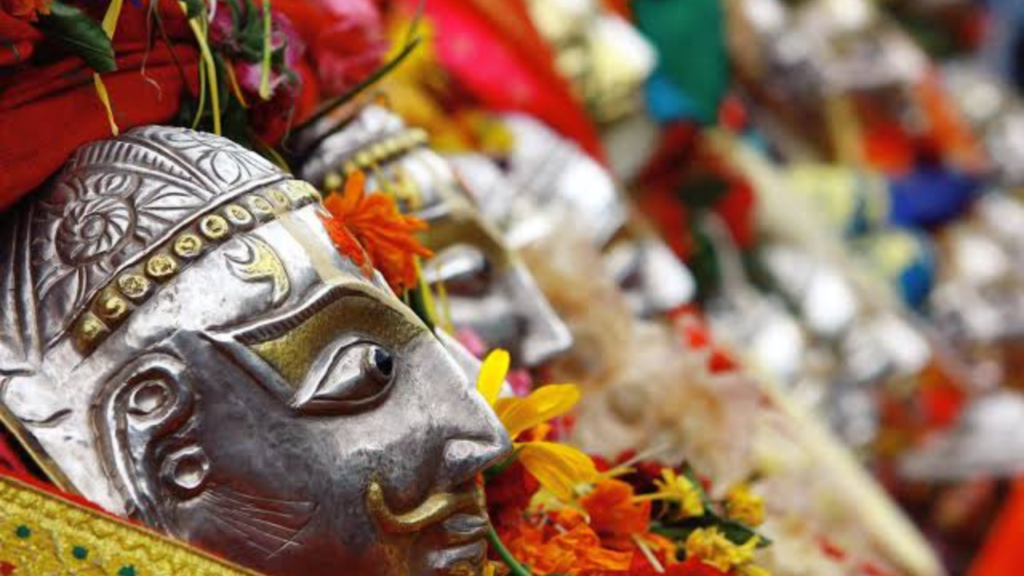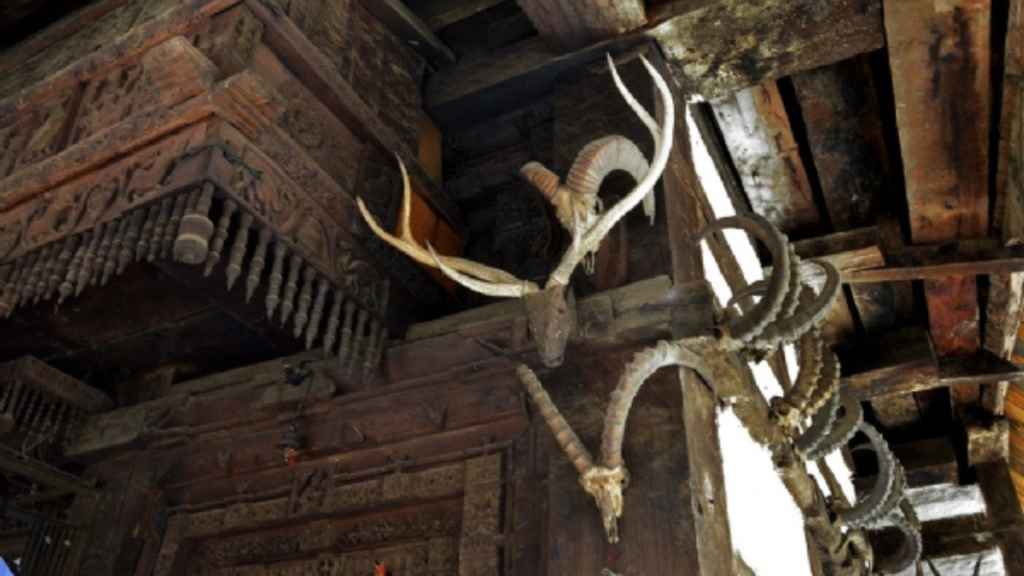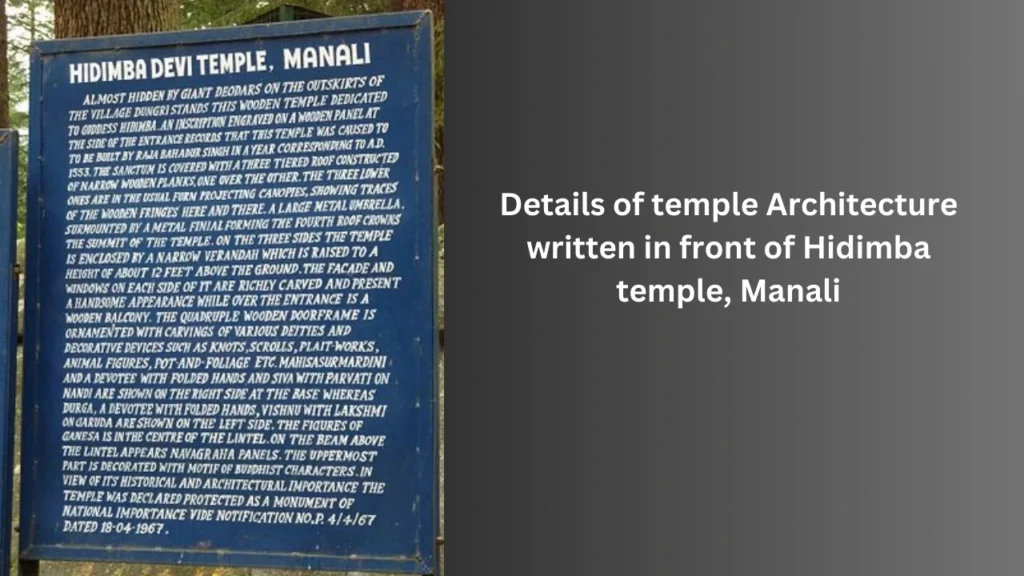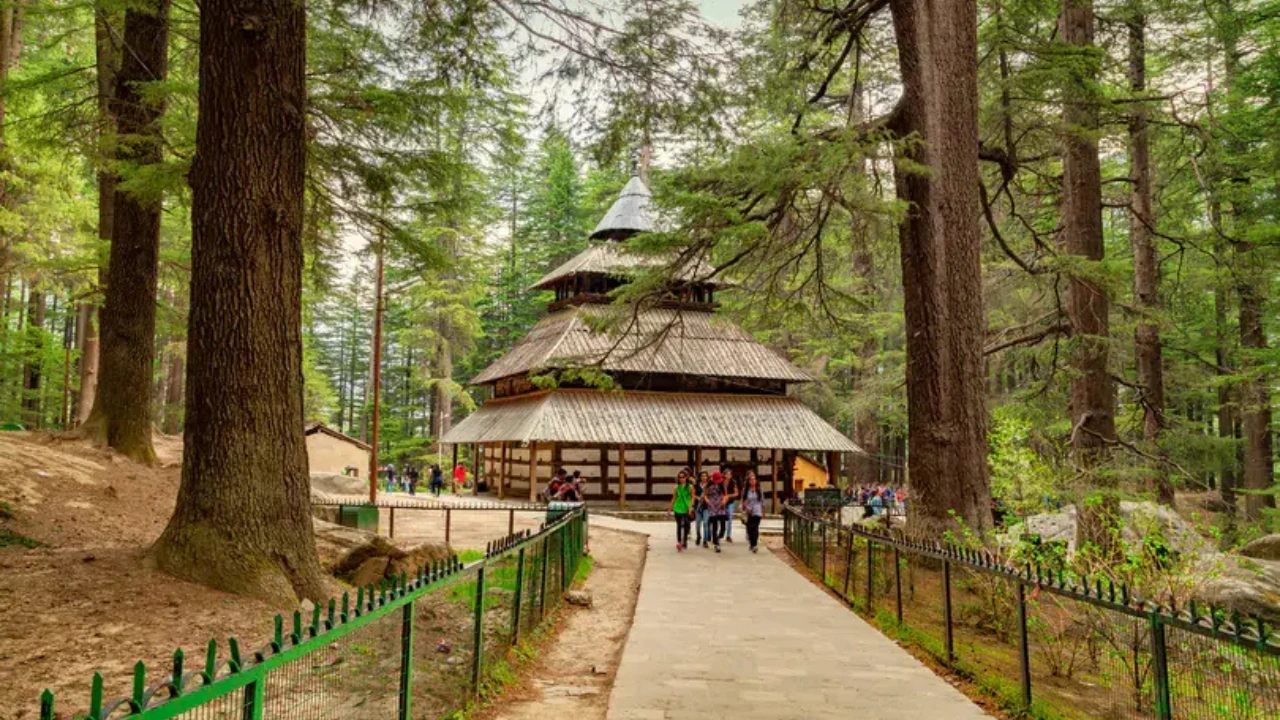The Hidimba Temple is one of the popular temples located in Manali, Himachal Pradesh. This temple is also locally known as Dhungari Temple, as the temple is surrounded by a cedar forest called Dhungiri Van Vihar at the foot of the Himalayas. This popular ancient temple is dedicated to Hidimba Devi, the wife of Bhima from the epic Mahabharata.
The Hidimba Temple is one of the must visit tourist attractions of the quaint hill town of Manali in Himachal Pradesh. It is situated between beautiful hills and surrounded by forest. This ancient Hindu place of worship was built in the 16th century by Raja Bahadur Singh. The main deity worshiped at this shrine is demon Goddess Hidimba. The temple is also referred to as Hidimba Devi Temple.
No idol of Goddess Hidimba has been placed inside the temple. A block of rock with carved footprints of the Goddess Hidimba is placed inside the temple to work. It is believed that Hadimba Devi used to meditate on this rock located inside the cave, around which the temple has been built. Locals believe that the Goddess Hidimba protects them from natural calamities and from all evil.
As Hidimba Devi Temple is nestled among lush greenery, a visit to the temple means an opportunity to feel spiritual while beholding pristine natural beauty all around. Large number of devotees visit the temple across the year, especially in the summer month. Tourists from different parts of the country visit Manali to relax in its pleasant weather.
During the summer month of May, the temple organizes a three-day Hadimba festival, which is marked by various cultural festivities based on local music, dance and folklore.
5 Secret Facts about Hidimba Temple

- The Hidimba Temple is dedicated to a noble demoness: The Hidimba Temple is unique as the temple is dedicated to Hadimba Devi, the wife of Bhima from the epic Mahabharata. As per Hindu legend, Hadimba was a demoness sister of demon Hidimb who later became a revered figure. She played a crucial role in the Mahabharata when she helped Bhima in his battles. The temple honors her as a goddess, and locals believe that she continues to protect them.
- Unique wooden architecture: Another outstanding thing about Hadimba Temple is its unique wooden architecture. It is a beautiful example of traditional wooden architecture that was built in 1553.The temple attracts intricate carvings on the wooden walls depicting mythological figures and scenes from the Mahabharata. The temple’s structure is unique as it has a pagoda-style roof that slopes steeply, and the entire temple is constructed using wood from the surrounding deodar trees.
- Location of the forest in the forest: One of the temple’s most interesting facts is its location. The temple is situated in a lush, green forest, surrounded by tall deodar trees, which add to the temple’s spiritual and serene atmosphere. The temple is located on a hilltop in the middle of the forest, far away from the bustling town of Manali. Devotees have to walk through this dense, peaceful forest to reach the temple. Simply beautiful.
- Goddess Hidimba’s footprint: There is a stone slab in the temple premises that features an imprint of goddess Hidimba’s foot, which is believed to be a mark of her divine presence. According to legend, this footprint represents her physical manifestation and is considered to be highly sacred by the locals. This footprint of the goddess is worshipped at this temple.
- Pilgrimage: The Hidimba Temple is not just a tourist attraction but also an important pilgrimage site for devotees which is visited by a great number of devotees all year around. Its connection to the Mahabharata and its association with Hadimba Devi make it a place of reverence. Every year, the temple hosts a grand fair during the festival of Dussehra, attracting pilgrims from all over the region.
History of Hidimba Devi
According to the hindu mythology, It is said that the Pandavas’ brothers (from the Indian epic Mahabharata) were passing through the Dhungri forest during their exile when they came across Hidimba and her brother, demon king Hidimb. These demons were torturing the villagers of the area. In order to protect the poor villagers, Bhima – the second brother among the Pandavas and the strongest of them fought with the demon Hidimb and defeated him.

Hadimba, sister of demon hidimb on the other hand, had vowed that she will marry whoever will defeat Hidimb in a fight. Hence, demon Hidimba married Bhima and they had a son named Ghatotkacha.
After Bhima along with his brothers went away from Manali, it was Hidimba devi who looked after the kingdom and took great care of the people. When Ghatotkacha attained adulthood, Hadimba devi gave the reins of the kingdom to him and she left for the forest, where she began meditation on a rock seeking penance for her sins.
Her prayers and meditations were answered by Goddess Durga, who blessed her to become a goddess. Since those times, goddess Hidimba has been worshipped by the local peoples. The Hadimba Temple is dedicated to Hidimba, the wife of the second brother of the Pandavas, Bhima. Though Hidimba devi was a demoness, with her nobleness she became a goddess.
During the period when the Pandavas were in exile, the second brother of the Pandavas Bheem, in a quest to save the villagers from the tortures of Hidimb, killed him and thus won the hand of Hidimba for marriage. Bheem and Hidimba had a son named Ghatotkacha who died fighting for the Pandavas in the Kurukshetra Battle.
A shrine dedicated to him is built near the Hadimba temple. After Bheem and the Pandavas went away from Manali, Hidimba stayed back to look after the kingdom. It is said that she was very kind and a great ruler. When her son Ghatotkacha came of age, Hidimba left the throne to her son and went into the forest to dedicate the rest of her life to meditation.
It is said that Hidimba sat on a rock doing hard penance to shed her demoness identity. After many years of meditation, her prayers were answered, and she was crowned with the glory of being a goddess. It is to honour her penance that the Hidimba Temple was built on this rock in 1553 in which she sat for meditation.
Architecture of Hidimba Temple
The Hidimba Temple is built in the Pagoda-style architecture. The temple is simply fascinating, especially its top most roof, which is made of metal while the other roofs feature timber tiles. This four-tiered structure is made up of wood and stones, with the former used in its doors and Shikhara (temple’s peak) while the latter used for its strong foundation. The Shikhara of the temple is 24 m high and looks as tall as the surrounding deodar trees.

The main entrance door of the temple is made of wood, featuring a carved image of Goddess Durga. The walls of the temple are beautifully decorated with figurines and carvings of different Hindu goddesses and various animals. The floor of the temple is made of white stones. The main center of the shrine has the footprint carved rock on which Goddess Hadimba used to meditate.

A few metres away from the Hadimba Temple lies a shrine dedicated to Hidimba and Bhima’s son Ghatotkacha. It consists of a stone block with the impression of what is believed to be Hidimba’s foot.
Festivals in Hidimba Temple
Local people believe that the Goddess still protects the forest and the people here, blessing them abundantly. She is worshipped as the Kuldevi (family deity) and Gram Devi (village deity)as well. While Navaratri elsewhere celebrates Goddess Durga, here, the spotlight shifts to Hidimba Devi, drawing devotees in droves. Navratri is the main festival celebrated annually during September-October month with great joy and enthusiasm. Navratri is dedicated to Goddess Durga, which is a nine day festival celebrated to worship nine incarnations of Goddess shakti.

There is a fair that is held annually in the month of May falling on the birthday of Hidimba Devi. This festival is marked by musical celebration and dance performed by the local womenfolk who visit the Dungri forest area.
The temple also hosts an annual festival with great fervour and zest, during the Hindi month of Shravan (July-August), in the memory of Raja Bahadur Singh, who constructed this temple. This fair is called ‘Bahadur Singh Re Jatar’ by the locals.
Things to do at Hidimba Temple
Besides worshipping at the Hidimba Devi Temple, tourists head to the nearby tree temple, which is devoted to Hidimba devi and bheema son Ghatotkacha. Tourists with an inclination towards natural beauty will find this place heavenly because of its natural beauty filled with lush greenery all around.
A nature walk among the Dhungri Van Vihar can definitely be a must do activity.Dhungri Van Vihar is a municipal garden situated close to the temple. The main highlight of the garden is a man-made lake, where boating facilities are available. The Museum of Himachal Culture & Folk Art, located near the temple, is also a popular attraction of Manali.
The museum boasts of exhibiting a wide range of artifacts of the state of Himachal Pradesh. Adventure lovers can go on an uncharted trek, which starts near the temple. This one-day trail, locally called Lamadugh – meaning deep and long – leads trekkers into the forest comprising Cedar, Maple, Chestnut, Pine and Oak trees.
Another must-do thing at this place is photography, especially of the temple’s alluring architecture. The scenic location of the temple surrounded by tall cedar trees is something that the nature photographers will definitely appreciate.
Hidimba Temple Entry Fee and Timings
There are no entry fees required to visit the temple. It remains open on all days, from morning 8 am till evening 6 pm.
How to Reach Hidimba Temple in Manali
The Hidimba Devi Temple is located close to the famous Mall Road of Manali. This popular temple is easily accessible by local transport services like auto-rickshaws and bikes. Since, the temple is situated only 2.7 km away from the Mall road, a lot of tourists walk up to the temple.
Tourists can also hire a taxi or cab in Manali for a one-day tour of Manali and keep this famous temple as part of their itinerary.
Tourists can reach Manali by all means of transport including Air, Rail and Road. The nearest airport to this hill station is Bhuntar Airport, which is about 50 km away. Joginder Nagar railway station, located at a distance of 146 km, is the nearest railhead to Manali. Many taxis and cabs are available at the airport and railway station which you can hire to reach your destination.
Road connectivity to this place is quite good with frequent buses available from important nearby cities like New Delhi, Chandigarh, Ambala, etc.
- Nearest Airport: The nearest airport to Hidimba Temple is Kullu-Manali Airport in Bhuntar which is located just 50 km away from Manali. Flights from all the major cities connect Manali with other parts of the country. At the airport, you can hire a car or taxi to reach the temple which will take you about 2 to 2.5 hours.
- Nearest Railway station: Joginder Nagar railway station is the nearest station to Hidimba Temple at a distance of 165.3 km.Alternately, people prefer Chandigarh (317.6 km) and Ambala (337.4 km) railway stations as
they connect Manali to the other major cities of the country. - By Road: There are a number of buses plying to Manali from Delhi daily. Manali is connected to major cities in North India through bus transport. From state seater buses to semi-sleepers of private operators, seat availability should not be a problem anytime.
Best Places to visit near Hidimba Temple
Solang Valley
Solang Valley is one of the most popular tourist destinations in Himachal Pradesh. It is popular for adventure sports. During winters, Solang valley is covered with snow making skiing a popular sport here. There are training institutes and trainers located to supervise skiers and train beginners.
Manali Mall Road
Manali Mall Road is one of the best places to walk in the evening. The road is surrounded by numerous hotels, restaurants, dhabas, booths, and shopping options. This Mall Road is considered as the soul of Manali. It is an ideal place to start exploring Manali, full of many activities that will get you engaged throughout the day. The Mall Road Manali embodies the charm of the hill town in all its glory.
Manikaran Sahib
Manikaran Sahib is located in the Parvati Valley of Himachal Pradesh, Manikaran Sahib is a significant religious site for both Sikhs and Hindus. It is one of the must visit sacred sites located amidst the scenic beauty of the Himalayas, this pilgrimage destination is popular for its hot springs, gurudwara, and ancient temples. The key reason to visit Manikaran Sahib is its spiritual significance, offering visitors a chance to immerse themselves in the divine atmosphere and seek blessings from god.
Atal Tunnel
Atal Tunnel also known as the Rohtang Tunnel, Atal Tunnel is a horseshoe-shaped highway tunnel that connects Manali and the Lahaul-Spiti valley. This tunnel is named after the former prime minister Atal Bihari Vajpayee, the tunnel is the world’s longest one above 10,000 feet and is constructed in the Pir Panjal ranges, under the Rohtang Pass.
Rohtang Pass
Rohtang pass is the stretch which connects Manali to Himachal’s more dreamy and dessert-like landscapes, Spiti and Lahaul. Pne can enjoy lots of popular adventure sports such as sledge ride, mountain biking, and skiing. The beauty of this place and the adventurous sport makes it a must visit place in Manali.
Discover other famous Temples in India
Frequently Asked Questions
-
When is the best time to visit Hidimba Temple ?
March to June is considered as the best time to visit this temple because the weather is cool and the scenery is green. It is the best time to explore the beauty of the Temple.
-
Where is the Hidimba temple located?
Hidimba Temple is located about 2.5 km from the main town of Manali. It’s located in a deodar forest on a hill in Manali, Himachal Pradesh.
-
What is there inside the Hidimba Temple?
The Hidimba Temple contains a large stone with the footprint of the goddess Hidimba, wife of Bheema.
-
What are some festivals celebrated at the Hidimba temple?
The temple hosts an annual festival called “Bahadur Singh Re Jatar” which is celebrated in the Hindi month of Shravan. Another festival is held annually on May 14th, the birthday of Hadimba Devi.
-
What is the significance of the Hidimba temple?
The Hidimba temple is considered one of the sacred sites for the locals and a popular
pilgrimage destination for tourists. -
How many entrance and exit gates are here at Hidimba Temple?
There is only a single entrance and exit gate for visitors in Hidimba Temple.
-
Which is the nearest airport to the Hidimba Temple ?The nearest airport to Hidimba Temple is Kullu-Manali Airport in Bhuntar 52.5 km away. From the airport, you can hire a car or taxi to reach the temple which will take you about 2 to 2.5 hours.
-
Which are some of the restaurants near Hidimba Temple ?
List of some of the Top and best restaurants located in Manali near to Hidimba Temple includes:
Manali sweets
Lazy Dog Lounge
Veer Restaurant
World Peace Restaurant
Cafe 1947
Rocky’s cafe
Casa Bella Vista

